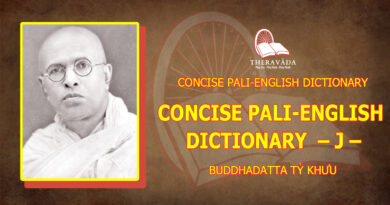TWO STYLES OF INSIGHT MEDITATION
TWO STYLES OF INSIGHT MEDITATION
Today the practice of insight meditation has become popular all around the world, yet to achieve this popularity it has undergone a subtle metamorphosis. Perhaps the most powerful pressure that has shaped the contemporary style of teaching insight meditation has been the need to transplant the practice into a largely secular environment remote from its traditional matrix of Buddhist faith and doctrine. Rather than being presented as an integral part of the Buddhist path to deliverance from samsàra, insight meditation is now taught as a self-contained discipline whose fruits pertain more to life within the world than to absolute release from the world. Many people who have taken up insight meditation eloquently testify to the tangible benefits they have gained, benefits that range from such relatively mundane goods as stress reduction and enhanced job performance to more spiritual ends like greater calm, deeper self-knowledge, and clearer awareness of the present.
While such benefits are certainly admirable in their own right, it must nevertheless be stressed that, taken by themselves, they do not constitute the final goal that the Buddha himself holds up as the end point of his training. That goal, in the terminology of the texts, is the attainment of Nibbàna, understood as the destruction of all defilements here and now and ultimate release from the beginningless round of rebirths. While the concrete results brought forth by the secularized practice of insight meditation will also permeate the experience of one who takes up the practice within a classical Buddhist framework, success in reaping these benefits is not necessarily an indication that one is drawing close to the final goal.
Given the sceptical climate of the present age and the stress on personal experience as a guide to truth, it is quite appropriate that newcomers to the Dhamma be invited to explore the potential inherent in the practice for themselves, without having the full agenda of Buddhist doctrine thrust upon them from the start as if it were another system of dogma. However, though we may initially take up the practice of meditation with an open and undogmatic attitude, at a certain point in our practice we inevitably arrive at a crossroads where we find ourselves faced with a choice. We can either continue with the meditation based upon the initial premises from which we started, generally a purely naturalistic worldview, or we can set off along a different track that leads to full actualization of the potential inherent in the practice. If we choose the first route, we might still deepen our meditation and reap more abundantly the same type of benefits we have obtained so far — deeper calm, more equanimity, greater openness to the present. Nevertheless, as worthwhile as these benefits might be in their own right, from the standpoint of the Dhamma they remain incomplete. For the practice of insight meditation to achieve its full potential as intended by the Buddha himself, it must be encompassed by several other qualities that rivet it to the framework of the teaching.
Foremost among such qualities are the complimentary pair of faith and right view. As a component of the Buddhist path, faith (saddhà) does not mean blind belief but a willingness to accept on trust certain propositions that we cannot, at our present stage of development, personally verify for ourselves. These propositions concern both the nature of reality and the higher reaches of the path. In the traditional map of the Buddhist path, faith is placed at the beginning of the training, as the prerequisite for the later stages comprised in the triad of virtue, concentration, and wisdom. The canonical texts do not seem to envisage the possibility that a person lacking faith in the specifically Buddhist sense could take up the practice of insight meditation and reap positive results from it. Yet today such a phenomenon has become extremely widespread, as many present-day meditators make their initial contact with the Dhamma through intensive insight meditation and use their experience as a touchstone for deciding exactly how to incorporate the Dhamma into the pattern of their lives.
On the basis of this choice, we find that meditators divide into two broad camps. One consists of those who focus exclusively upon the immediately tangible benefits of the practice, suspending all concern with what lies beyond the horizons of their own experience. The other consists of those who recognize that the practice flows from a source of wisdom much deeper and broader than their own. In order to follow this wisdom in the direction to which it points, such meditators are ready to subordinate their own understanding of the world to the disclosures of the teaching and embrace the Dhamma as an organic whole. These are the ones who adopt Buddhism in its religious and doctrinal sense as the framework for their practice.
The fact that insight meditation can be earnestly practised even without the sustaining role of faith raises an interesting question never explicitly posed within the canon and commentaries. If insight meditation can be pursued solely for the sake of its immediately visible benefits, what role does faith play in the development of the path? Certainly faith, in the sense of a full acceptance of Buddhist doctrine, is not a necessary condition for the undertaking of the precepts or the practice of meditation. As we have seen, those who lack faith in the distinctively Buddhistic tenets of the Dhamma might still accept the Buddhist precepts as guidelines to right conduct and practise meditation as a way to inner happiness and peace. Thus faith must play a different role than that of a simple spur to action.
Perhaps an answer to our question will emerge if we ask, “What exactly does faith mean in the context of Buddhist practice?” It should be clear at once that faith cannot be adequately explained simply as reverence for the Buddha as a great spiritual teacher, or as some alloy of devotion, admiration, and gratitude. For while these qualities often exist alongside faith, they may all be present even when faith is absent. If we look at faith more closely, we would see that besides its emotional constituents, faith also involves an indispensable cognitive component. This component consists in a readiness to accept the Buddha as the unique discoverer and proclaimer of liberating truth. From this angle, faith is seen to involve a decision. As the word “decision” implies (“to decide” = to cut off), to place faith in something is to exercise an act of discrimination. Thus Buddhist faith entails, at least implicitly, a rejection of the claims of other spiritual teachers to be bearers of the liberating message on a par with the Buddha himself. As a decision, faith also entails acceptance, that is, a willingness to open oneself to the principles made known by the Enlightened One and accept them on trust as reliable presentations of the real nature of things and of the proper way of life.
It is this decision that marks the distinction between one who takes up the practice of insight meditation as a purely naturalistic discipline and one who takes it up within the framework of Buddhist faith. The former, by suspending any judgement about the picture of the human condition imparted by the Buddha, limits the fruits of the practice to those that are compatible with a purely naturalistic worldview. The latter, by accepting the Buddha’s own picture of the human condition, gains access to the goal held up by the Buddha as the final fruit of the practice, complete deliverance of mind and the realization of Nibbàna.
The second pillar that supports the practice of insight meditation is the cognitive counterpart of faith, namely, right view (sammà ditthi). Though the word “view” might suggest that the practitioner actually sees the principles considered to be “right,” at the outset of the training this is seldom the case. For all but a few exceptionally gifted disciples, “right view” initially means right belief, the acceptance of principles and doctrines out of confidence in the enlightenment of the Buddha. Though Buddhist modernists often claim that the Buddha said that one should believe only what one can see and verify for oneself, no such statement is found in the Pali Canon. What the Buddha does say is that one should not accept his teachings blindly but should inquire into their meaning and attempt to realize their truth for oneself. There are, however, many principles taught by the Buddha as essential to right understanding that we cannot, at the outset of training, ascertain for ourselves. These are by no means umimportant, but define the entire framework of the Buddha’s programme of deliverance. They delineate the deeper dimensions of the suffering from which we need release, point in the direction where true liberation lies, and prescribe with pinpoint precision the steps to be followed to arrive at the liberating wisdom.
These principles include the tenets of both “mundane” and “transcendent” right view. Mundane right view is the type of correct understanding that leads to a fortunate destination within the round of rebirths. It involves an acceptance of the principles of kamma and its fruit; of the distinction between meritorious and evil actions; of the vast expanse and multiple domains of samsàra within which rebirth may occur. Transcendent right view is the view leading to liberation from samsàra in its entirety. It entails understanding the Four Noble Truths in their deeper dimensions, as offering not merely a diagnosis of psychological distress but a description of samsàric bondage and a programme for final release. It also involves understanding dependent origination as an account of the causal dynamism of samsàra; recognizing the inadequacy in all conditioned modes of being; and accepting Nibbàna as the sphere that offers final deliverance from suffering.
While the actual techniques for practising insight meditation may be identical whether it be pursued as a purely naturalistic discipline or taken up as an integral part of the Buddha’s path, the two styles of practice will nevertheless differ profoundly with respect to the results those techniques are capable of yielding. When practised conscientiously within the framework of a naturalistic understanding, insight meditation will bring greater calm, understanding, and equanimity. It will purify the mind of the coarser layers of defilements and can culminate in a tranquil acceptance of life’s vicissitudes coupled with a capacity for compassionate action. Thus this style of practice should not be disparaged. However, practice in this style will still remain confined to the sphere of the conditioned; it will still be tied to the round of wholesome kamma and its fruit. It is only when insight meditation is buttressed from below by deep faith in the Buddha as the perfectly enlightened teacher, and illuminated from above by the wisdom of the Buddha’s teachings, that it acquires the power to cut away all the fetters that have kept us in bondage through beginningless time. It then becomes the key to open the doors to the Deathless, to winning a freedom that can never be lost. With this, insight meditation transcends the limits of the conditioned, transcends even itself, and arrives at its proper goal: the unconditioned truth of Nibbàna, final release from all fetters and from the round of birth,aging, and death.
Bhikkhu Bodhi
BPS Newsletter, No. 45, 2000,







